2023 Ford Ranger v Volkswagen Amarok v Toyota HiLux
Top end utes are big business in Australia and we put three of the best to the test to see which one is king on and off the road. SEE THE WINNER HERE.
Car Advice
Don't miss out on the headlines from Car Advice. Followed categories will be added to My News.
The fight for the title of Australia’s best-selling car is in full flight, as Toyota’s ageing HiLux battles to stay on top against the newer Ford Ranger. But a third contender, in the form of a new Volkswagen Amarok, could bloody both their noses.
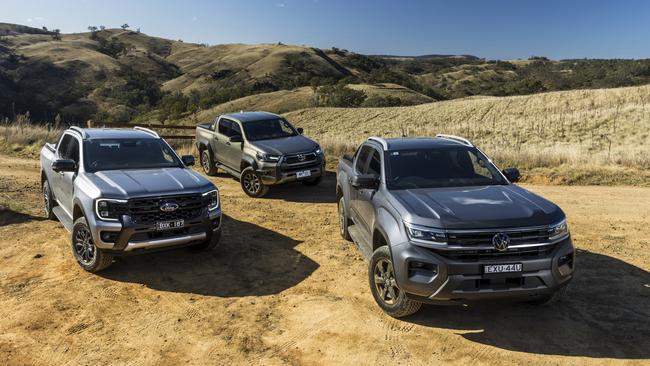
Toyota HiLux Rogue
As the first – and only – ute to top the sales charts, the Toyota HiLux is firmly established as an Australian favourite.
The undisputed heavyweight champion of Australian new-car sales was updated in top-end Rogue trim in mid-2022, benefiting from butch bodywork, heavily revised suspension and the addition of rear disc brakes in a package that shapes up taller and wider than anything else in the range.
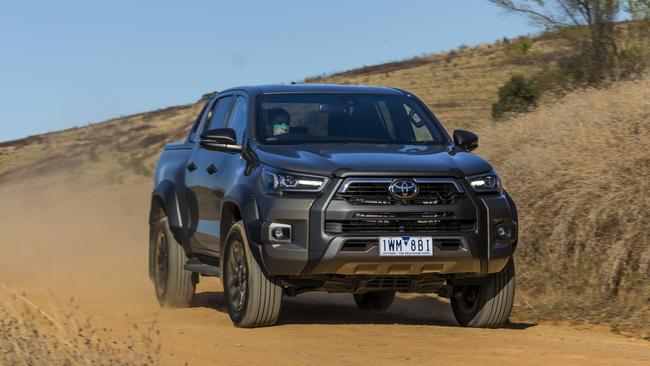
Priced from about $76,000 drive-away, the Rogue is the most modern and expensive model in the HiLux range. Pitched toward “concrete cowboys” who want to own a ute without compromising on creature comforts, the Rogue has heated leather seats, a JBL stereo and dual-zone climate control.
A powered metal roller blind covers a tray trimmed in waterproof carpet – perfect for keeping a kayak or golf clubs in good condition, but less ideal for shifting a tonne of topsoil or a muddy quad bike.
Powered by a 2.8-litre four-cylinder engine, the HiLux uses 7.9L/100km to make 150kW and 500Nm, outputs that would have turned heads a decade ago but are nothing out of the ordinary in 2023.
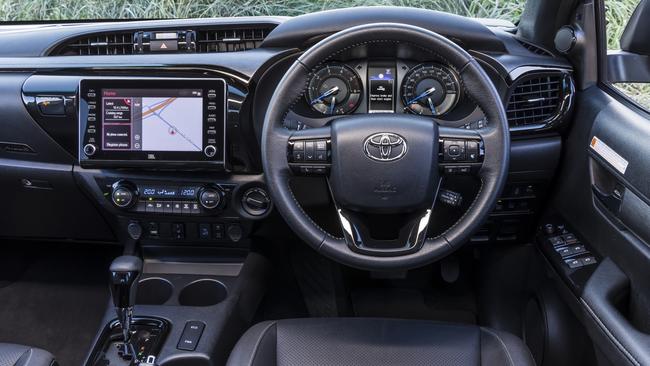
The same goes for a cabin that combines old-school analog gauges with a modest driver’s display.
An 8-inch central infotainment screen has sat nav, Apple CarPlay and Android Auto, but you’ll need a cord to hook up smartphones and there’s no wireless charging pad.
Adequate in isolation, the system feels outdated alongside the Ford and VW with their iPad-like screens.
The Toyota’s engine feels stressed and coarse in this company, its six-speed transmission lacking the flexibility of rival 10-speed gearboxes.
The HiLux’s ride is jiggly and nervous on broken ground, and its simple four-wheel-drive hardware doesn’t adapt to prevailing terrain.
Overly intrusive traction and stability control systems sap confidence on dirt, where the Ford and VW – and their more aggressive rubber – have a clear advantage.
Ford Ranger Wildtrak
Ford hit the ground running with an all-new Ranger last year.
Smarter and stronger than before, the car has won critical acclaim and thousands of customers. It’s slightly bigger than many rivals and
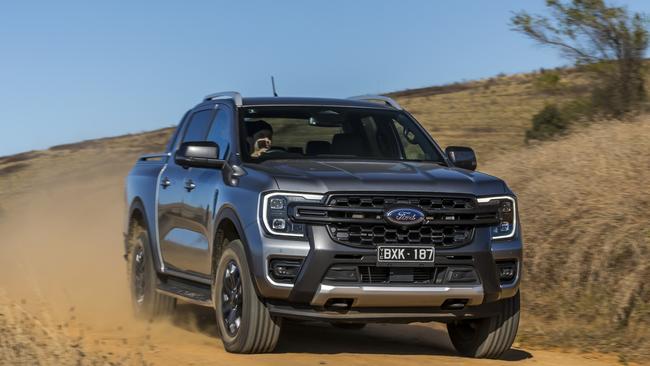
has a masculine presence on the driveway or the open road.
Styling inspired by America’s Ford F-150 joins clever touches including footholds moulded into bodywork near the back tyres, a genius inclusion bafflingly absent from the mechanically identical Amarok.
We tested the car in popular Wildtrak V6 trim priced from about $79,000 drive-away. It costs more than the HiLux but makes up for the difference with tech including a digital dashboard and 12-inch infotainment screen with wireless smartphone mirroring.
The Ranger has more safety gear than older utes (including a front centre airbag), along with hardware that is the envy of many manufacturers.
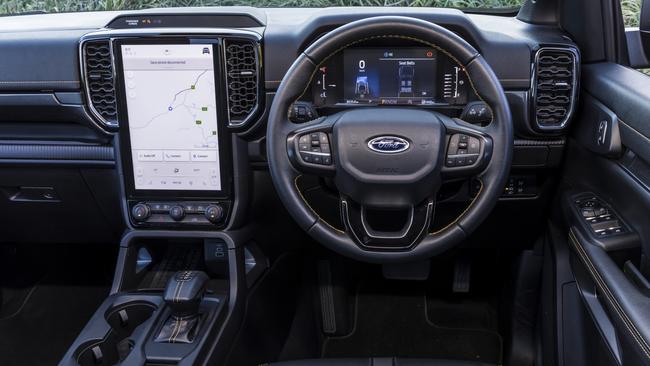
A 3.0-litre V6 turbo diesel motor uses 8.4L/100km to produce class-leading 184kW and 600Nm punch. Better yet, the engine is smooth and polished.
A 10-speed automatic transmission offers a broad spread of ratios, sending power to all-terrain tyres through a sophisticated drive system that includes a full-time adaptive four-wheel-drive mode that provides better traction on tar than the HiLux.
Quiet on the highway, the Ford has a planted, weighty feel helped by the softest suspension of this trio. It feels substantial on tarmac and gravel, with confidence-inspiring composure in a broad variety of conditions.
Finely honed traction control works brilliantly on slippery surfaces, allowing enough slip to maintain progress, but not so much that the car feels like it could step beyond the bounds of control.
It’s an excellent all-rounder and a credit to the scores of Aussie engineers who helped make it happen.
Volkswagen Amarok Pan Americana
The VW Amarok takes the bones of the Ford Ranger and attempts to make it better.
Volkswagen worked closely with Ford to develop the new model, which is built by the Blue Oval in South Africa.
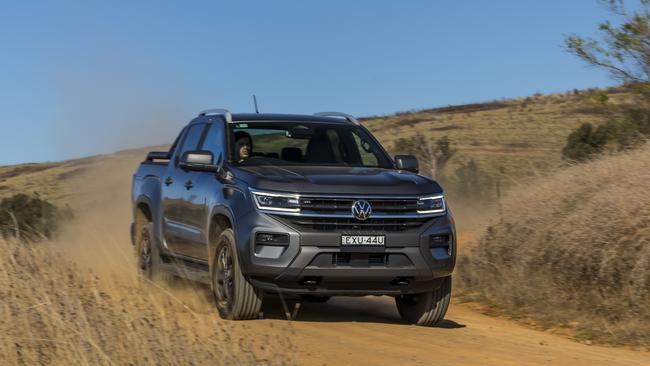
It has the same V6 engine, 10-speed auto and sophisticated drive system as the Ford.
It also has the same nine airbags and comprehensive array of safety gear, but there are important differences between the pair.
Volkswagen charges more for the Amarok. This Pan Americana version costs a shade more than $83,000 drive away, while delivering more generous features than the Ford.
It has a larger digital dash than the Wildtrak, along with matrix LED headlights and a posh Harman Kardon stereo that Ford either reserves for dearer variants, or places on the optional extras list for the Wildtrak (a premium pack costs $1850).
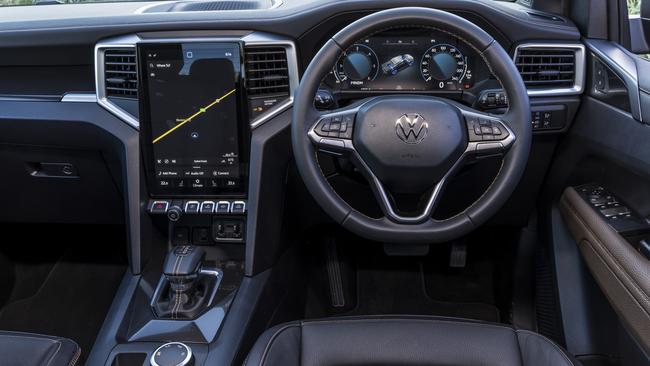
The VW is slightly less practical. It misses the Ford’s side steps, deletes a convenient storage area in front of the passenger and lacks a cover for the rear tray. But it feels more car-like in the cabin, with deeply bolstered seats, a steering wheel pinched from VW’s passenger range and nicer materials on the dash and doors.
It’s just as roomy as the Ranger, but seems quieter at speed.
VW’s contender has lighter and more accurate steering than the Ford or Toyota, helped by slightly firmer shocks that reduce body roll when changing direction.
It’s the pick of the group on smooth tarmac.
The trade-off is that the VW’s ride is less settled on rough roads. It’s bouncier than the Ranger without a load in the tray, feeling comparatively nervous on dirt.
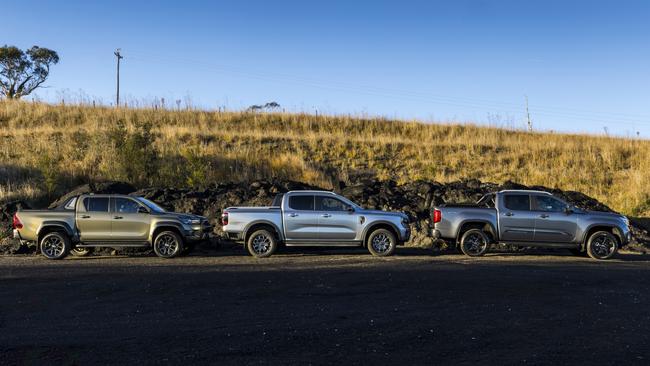
Verdict
The HiLux takes bronze here, which shouldn’t come as a surprise, given how long it has been on sale. Expect Toyota to deliver something special when an all-new model arrives in a couple of years. Silver goes to the Amarok. Polished road manners and a superior cabin are undermined by a high price and reduced utility compared to the Ranger. That leaves the Ford as the winner.
FORD RANGER WILDTRAK V6
PRICE: About $79,000 drive-away
ENGINE: 3.0-litre V6 turbo diesel, 184kW and 600Nm
WARRANTY/SERVICE: 5-yr/u’ltd km, $329 per year
SAFETY: Nine airbags, front/rear auto emergency braking, active cruise, lane-keep and blind-spot assist, rear cross-traffic alerts
THIRST: 8.4L/100km
SPARE: Full size
TOWING: 3500kg
VW AMAROK PANAMERICANA
PRICE: About $83,000 drive-away
ENGINE: 3.0-litre V6 turbo diesel, 184kW and 600Nm
WARRANTY/SERVICE: 5-year/u’ltd km, $360 per year
SAFETY: Nine airbags, auto emergency braking, active cruise control, lane-keep and blind-spot assist, rear cross-traffic alert
THIRST: 8.4L/100km
SPARE: Full-size
TOWING: 3500kg
TOYOTA HILUX ROGUE
PRICE: About $76,000 drive-away
ENGINE: 2.8-litre 4-cyl turbo diesel, 150kW and 500Nm
WARRANTY/SERVICING: 5-yr/u’ltd km, $520 per year
SAFETY: Seven airbags, auto emergency braking, active cruise control, lane departure alert, road-sign assistance
THIRST: 7.9L/100km
SPARE: Full size
TOWING: 3500kg
Originally published as 2023 Ford Ranger v Volkswagen Amarok v Toyota HiLux


